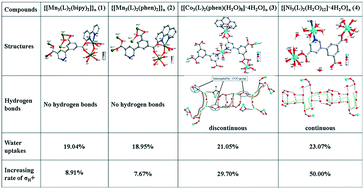Proton conductivities of four low dimensional MOFs: affected by the amount of chelated ligands†
Abstract
Four low dimensional MOFs, {[Mn3(L)2(bipy)2]}n (1), {[Mn3(L)2(phen)2]}n (2), {[Co3(L)2(phen)(H2O)8]·4H2O}n (3) and {[Ni3(L)2(H2O)12]·4H2O}n (4) (H3L = 5-(3′,5′-dicarboxyphenyl) nicotinic acid; bipy = 2,2′-bipyridine; phen = phenanthroline) have been synthesized and characterized. For compounds 1 and 2, Mn(II) cations were connected by L3− ligands to form 2D layered structures. Their crystal structures contained a high proportion of bipy or phen chelated ligands and no water molecules or hydrogen bonds. For compound 3, metal cations were connected to form a 1D coordination chain, the proportion of phen was reduced and some water molecules as terminal ligands occupied partly the coordination sites of metal cations. Hydrogen bonds, existing among water molecules and carboxyl groups, were discontinuous in compound 3. In the structure of compound 4, Ni(II) cations were linked to form a 2D layered structure. There was no phen ligand, more water molecules acted as the terminal ligands and were involved in the formation of continuous hydrogen bonds. The studies of proton conductivity showed that compounds 1 and 2 had little contribution to the proton conductivities of the composite membranes; while compounds 3 and 4 can enhance the proton conductivities of composite membranes by about 29.70% and 50.00% higher than that of pure Nafion. The highest proton conductivity of 4/Nafion may be caused by its highest water uptake and continuous hydrogen bonds, which were affected by the amount of water molecules. Analysis of the structure–property relationship revealed that the smaller the proportion of the chelated ligand, the more water molecules in the compound, which increased the chance of forming continuous hydrogen bonds, enhanced the water absorption ability, and improved the proton conductivity of the compound.

- This article is part of the themed collection: Crystal Engineering Techniques


 Please wait while we load your content...
Please wait while we load your content...